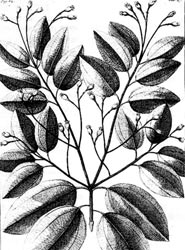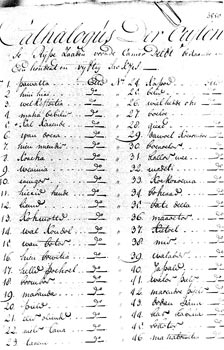| When Lanka’s
haven of herbs became the centre of research
By Dr. K. D. Paranavitana
It is a little known fact that the
Dutch Hospital in Colombo once functioned as the centre
of botanical studies in Sri Lanka. Therefore, it is
appropriate that this article follows the ‘Dutch
Hospital by the side of the harbour’ published
last week.
After the Dutch took over the administration
of the maritime regions of the island in 1656, the importance
of studying Sri Lankan flora and fauna was highlighted
especially by writers Phillipus Baldaeus in his True
and exact description of the great island of Ceylon
(1672) and Wouter Schouten in his Remarkable Voyage
(1676). Robert Knox in his work An historical relation
of Ceylon (1681) paid serious attention to the Sri Lankan
herbaria.
 |
| Drawing of Cinnamon plant from
Burman, 1737 |
“All their cures,” says
Baldaeus, “consist of pure empirics and experience.
They possess great written folios, which had been passed
to them from their fore-fathers, to which they have
added the results of their own researches. All their
purgatives are administered either in pills or mixtures,
which are composed of various medicinal herbs; in the
case too profuse a discharge of the bowels, they advise
the patient to apply a little black pepper ground with
water on or about their navel. I have myself experienced
this to be a sovereign remedy and it is good for all
cases of Tormina Ventris or stomach troubles and for
checking strong stools.” (Baldaeus, Tr. Ch. 47,
p.376)
Commenting on the Sri Lankan herbs
Robert Knox observes that, “The woods are their
apothecaries shops, where with herbs, leaves and the
rinds of trees they make all their physic and plaisters
with which sometimes they will do noble cures….A
neighbour of mine Chingulay, would undertake to cure
a broken leg or arm by application of some herbs that
grow in the woods, and that with that speed, that the
broken bone after it as set should knit by the time
one might boyl a pot of rice and three carrees, that
is about an hour and half or two hours; and I knew a
man who told me he was thus cured.” (Knox, Ch.
V, p. 28)
 |
| Page from the catalogue of seeds
sent to Botanical Garden in Leiden,1746. |
Robert Knox, published his work An
historical relation of Ceylon, in 1681 embodying his
findings on the native medicinal plants. This work which
was translated into Dutch in 1692 drew the attention
of botanists in the Netherlands for the medicinal and
exotic plants, trees, vegetables, fruits and spices
of Sri Lanka.
Quite apart from the writers referred
to, the administrators were also interested in different
aspects, mainly the personal and economic factors associated
with Sri Lankan botanical studies. The crews of the
Dutch East Indiamen generally suffered from scurvy and
other shipboard diseases. For example, ten East Indiamen
from the Netherlands carrying 2653 persons suffered
heavy casualties and 1095 or 43% of them died before
reaching Cape of Good Hope while 915 survivors were
admitted to the hospital — such was the situation
in the Cape in 1782. The Cape of Good Hope was then
considered as the ‘Tavern of the Indian Ocean’.
The next major comfortable port of
call for the seafaring Dutch population to the East
was Colombo. The sailors who landed in Colombo were
in need of fresh water, green vegetables and fresh meat.
These contributed more to their recovery than a doctor
with his medicines. Probably the increasing mortality
on board during the second half of the 18th century
was due to chronic ill-health of many men on the ships.
Therefore, the Dutch authorities had to expand the hospital
in Colombo and enhance the studies in medical herbaria
to reduce the heavy cost of medicines, imported from
Europe.
The first considerable report by a
Dutchman on the natural science of the island was compiled
by Robert Pathbrugge in 1668. He reported on the possibilities
of finding iron and saltpetre and proposed improving
forestry and collecting information on useful plants.
A substantial contribution was also made by Hendrik
Adriaan van Reede tot Drakenstein during his sojourn
in Sri Lanka as the High Commissioner of the Dutch East
India Company in 1685.
He became a world famous botanist
after his well-known work Hortus Malabaricus (1678-1693),
extending to twelve volumes dealing mainly with Asiatic
flora. He inspected southern Sri Lanka in 1685 and collected
plants for the botanical garden in Amsterdam. In his
capacity as the High Commissioner, he issued an ordinance
commanding high ranking officials to prepare an annual
list of plants and seeds with their names and despatch
it to the headquarters in the Netherlands.
This collection from Colombo went
in two directions, one to Stadhouder Willem III (1672-1702)
who gave it to the botanic garden in Leiden. The other
went to the botanic garden in Amsterdam. The orders
and the good work started by Van Reede continued having
the Dutch Hospital in Colombo as the responsible centre.
The Swedish doctor Herman Nicolai
Grimm attached to the Colombo Hospital (1674) started
collecting medicinal plants, vegetables and minerals
and combined all his experiences in a handbook titled
Labaratorium Chymicum (1677). This was perhaps the first
serious work on the study of natural sciences in Sri
Lanka and was printed at the Dutch East India Company
press in Batavia, present Jakarta in Indonesia.
The foundation for the study of natural
science in the island was laid by Paul Hermann, a German
Doctor attached to the Dutch hospital in Colombo, between
1672 and 1680. He built up a collection of animals preserved
in nitric acid together with a large collection of dried
plants. He was more interested in Sri Lankan flora,
especially plants with medicinal properties. He consulted
the local physicians and learned the etymology of their
Sinhala names and their applications in various tropical
diseases. He despatched a large portion of his collection
to Arnold Syen, Prof. of Botany in the University of
Leiden and to Jan Commelin who was a well-known chemist
in Amsterdam.
Syen was succeeded by Paul Hermann
to the chair of botany in the University of Leiden in
1680. He took his entire collection of Sri Lankan plants
and animalia to his official residence in Leiden. This
collection went under the auctioneer’s hammer
after his death and disappeared. However, the catalogue
of plants he prepared was published posthumously under
the title Musei Indici (1711), and Museum Zeylanicum
(1717) providing a source of information on studies
of the natural science of Sri Lanka.
The lists sent to the Netherlands
consisted of an average of 150 plants at a time. At
a later stage these reports giving plant names had a
short description of their medicinal value. It is remarkable
that Professor Pieter Hotton of the University of Leiden
wrote a comprehensive research paper on the medicinal
value of Ackmella in curing stones in the kidney referred
to as renal calculus, to Philosophical Transactions
in 1702.
At the end of the 17th century, during
the tenure of office of the Governors, Laurens Pijl
(1680-1692) and Thomas van Rhee (1693-1697) they initiated
a step forward and prepared in two volumes codex of
beautiful water colour drawings of Sri Lankan plants
with short descriptions. Prof. David van Royen of the
University of Leiden received a few boxes of Sri Lankan
plants in 1769, 1771, and 1777. Simultaneously, Amsterdam
Professor Johannes Burman received similar boxes in
1771 and 1773.
Knowledge on Sri Lankan plants was
enhanced with the publication of Johannes Burman’s
Thesaurus Zeylanicus in 1737. He added an alphabetical
summary of well-known Sri Lankan plants to his work
with the help of a contemporary Swedish botanist Carolus
Linnaeus who stayed at his residence for some time.
Linnaeus was an indefatigable researcher who went after
the missing collection of Sri Lankan plants belonging
to Prof. Paul Hermann. A few years later he found it
with an auctioneer in Copenhagen. These two botanists
joined together and published an excellent work on Sri
Lankan botany titled Species Plantarum (1753) which
marked a substantial turning point in Sri Lankan botany
to modern botanical studies.
The last Dutch botanist associated
with the Colombo Dutch hospital was Carl Per Thunberg
who studied Sri Lankan flora between 1777 and 1778.
The plant and the flower that any Sri Lankan knows as
Thunbergia, is named after him. His collection of Sri
Lankan flora was considerably large and on his return
to the Netherlands it was gifted to the botanical garden
in Amsterdam and a part of it to his friend, Doctor
Martrinus Houtthuin who published them with descriptions
in his work Natuurlijk Historie (1761-1785).
In 1796, the British took over the
territory under the control of the Dutch and in 1811
William Kerr, on orders of the king of Britain established
a botanical garden in Slave Island in Colombo by the
side of the Beira Lake. This was named after the Royal
Botanical Garden in Kew, London and the street name
‘Kew Road’ in Slave Island still exists.
This longstanding combination of botanical
studies between Leiden and Colombo, begun by Prof. Paul
Hermann was expanded laying a solid foundation for botanical
studies in the island. This tradition was continued
with the help of Smithsonian Institute in Washington
and the State Botanic Garden in Leiden by producing
a standard work for Sri Lankan botany titled A revised
handbook to the flora of Ceylon under the editorship
of Fosberg and Dissanayake running into fifteen volumes.
| 